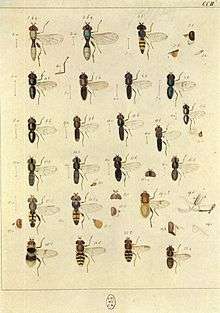Cheilosia antiqua
Cheilosia antiqua is a European species of hoverfly.[1]
| Cheilosia antiqua | |
|---|---|
 | |
| Cheilosia antiqua in Meigen Europäischen Zweiflügeligen (figure 8) | |
| Scientific classification | |
| Kingdom: | |
| Phylum: | |
| Class: | |
| Order: | |
| Family: | |
| Subfamily: | |
| Tribe: | |
| Genus: | |
| Species: | C. antiqua |
| Binomial name | |
| Cheilosia antiqua (Meigen, 1822) | |
| Synonyms | |
Description
External images
For terms see Morphology of Diptera
The wing length is 5 ·75-8·25 mm.
Face with a conspicuous central prominence. Frons and facial prominence undusted. Thorax shining black with fine punctures. Legs entirely black. Part of the antiqua species group and difficult to determine.
[2]
[3]
[4][5] The larva is illustrated by Rotheray (1993)[6]
Distribution
Cheilosia antiqua is a Palearctic species with a limited distribution in Europe Ireland to Central Europe and Southern Europe, Balkans, Greece, European parts of Russia.[7][8]
Biology
The habitat is deciduous forest and unimproved pasture, including montane and subalpine pasture. Found in clearings and beside tracks in woodland and along old hedgerows. In the open in montane pasture. Flowers visited include Caltha, Cardamine, Fragaria, Iris, Ranunculusand Taraxacum.The flight period is April to June.[9][10]
References
- Stubbs, Alan E. & Falk, Steven J. (1983). British Hoverflies: An Illustrated Identification Guide (2nd (revised) ed.). British Entomological & Natural History Society. p. 271, xvpp. ISBN 0-9502891-3-2.
- Van Veen, M. (2004) Hoverflies of Northwest Europe: identification keys to the Syrphidae. 256pp. KNNV Publishing, Utrecht.
- Van der Goot,V.S. (1981) De zweefvliegen van Noordwest - Europa en Europees Rusland, in het bijzonder van de Benelux. KNNV, Uitgave no.32: 275pp. Amsterdam.
- Bei-Bienko, G.Y. & Steyskal, G.C. (1988) Keys to the Insects of the European Part of the USSR, Volume V: Diptera and Siphonaptera, Part I. Amerind Publishing Co., New Delhi. ISBN 81-205-0080-6.
- Coe, R.L. (1953) Diptera: Syrphidae. Handbks.ident.Br.insects, 10(1): 1-98. R.ent.Soc.London. pdf
- Rotheray G., 1993 Colour Guide to Hoverfly Larvae Diptera, Syrphidae in Britain and Europe Dipterists Forum pdf Archived 2019-04-03 at the Wayback Machine
- Fauna Europaea
- Peck, L.V. (1988) Syrphidae. In: Soos, A. & Papp, L. (eds.) Catalogue of Palaearctic Diptera, 8: 11-230. Akad.Kiado, Budapest.
- de Buck, N. (1990) Bloembezoek en bestuivingsecologie van Zweefvliegen (Diptera, Syrphidae) in het bijzonder voor België. Doc.Trav. IRSNB, no.60, 1-167.
- Speight, M.C.D. (2011). "Species accounts of European Syrphidae (Diptera)" (PDF). Syrph the Net, the database of European Syrphidae. 65: 285pp.